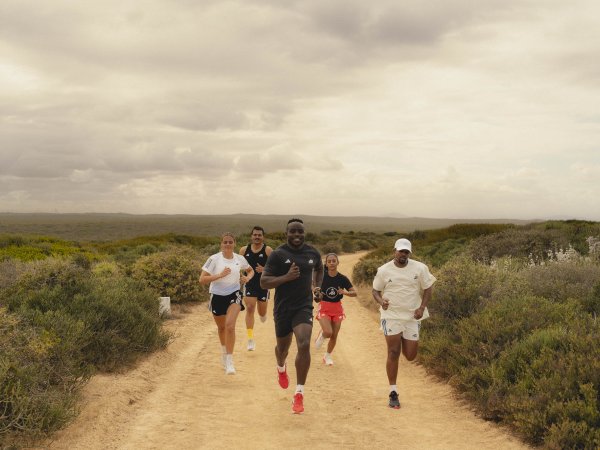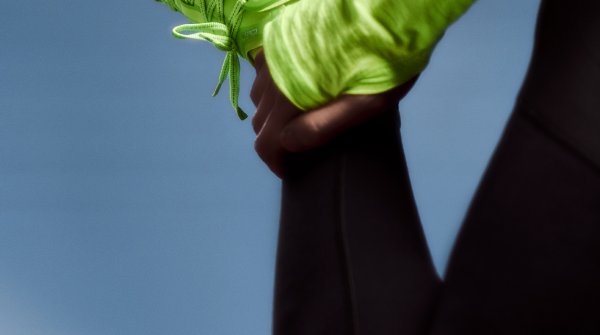The sports market is changing and is characterized by numerous developments. On the one hand, there are clear growth trends in areas such as outdoor activities, yoga and running. These benefit from the increased need of many people for holistic health, nature experiences and low-threshold opportunities for physical activity. They reflect the trend of no longer viewing sport solely in terms of performance, but as a means of mental relief, personal balance and everyday health care. At the same time, the running sector in particular also reflects the interest in competition and community through the increasing number of running events.
At the same time, society is becoming increasingly sporty: Sporty clothing is becoming an everyday look, fitness tracking is becoming a habit, and exercise is also being integrated as a matter of course outside of traditional training environments, be it during commutes, lunch breaks or via digital offerings at home. Health and wellness are becoming increasingly important, especially for the younger generation, which is further driving demand for versatile, flexible and health-oriented offerings.
Despite these positive developments, the overall picture is ambivalent: the proportion of the population that is active in sports is decreasing worldwide. The health trend is countered by a lack of exercise, increasing screen time and structural barriers, for example in urban areas or in poorer sections of society. The booming sportswear market, which has benefited greatly from the athleisure trend in recent years, is facing increasing competition and a slowdown in momentum. The first signs of saturation are having a noticeable impact on demand.
A key driver of innovation and differentiation is the commitment to greater sustainability. Companies are responding with new materials, circular production concepts and resource-conserving supply chains. The second-hand market is growing, as is interest in repair, rental and recycling models. New findings should also help to reduce the ecological impact of sports fashion. Nevertheless, the contradiction remains: Despite the increased interest in sustainable consumption, the overall demand for textiles continues to grow, which exacerbates the ecological challenges.
Where does the sports market stand? These international studies from the year 2025 provide important insights.
Directly to the findings on wellness as a growth driver:
Health is playing an increasingly important role in the sports market because the understanding of sport has fundamentally changed, moving away from pure performance orientation towards holistic well-being. Driven by Generation Z, the global wellness industry, worth around two trillion US dollars (1.7 trillion euros), is also undergoing radical change. A recent survey of more than 9,000 consumers in China, Germany, the United Kingdom and the United States by McKinsey shows: Young consumers such as Gen Z and millennials not only invest an above-average amount in their health, but also redefine the term "wellness". They are tech-savvy, informed, open to new products and think of wellness in 360-degree categories: Sleep tracking, mindfulness, mental balance, skincare (e.g. "skin cycling") and functional nutrition are just as much a part of this as physical fitness. For the sports industry, this means that wellness is no longer a marginal topic, but a central business area with strategic relevance. According to the study, Gen Z is prepared to invest time and money in their well-being, not just occasionally, but permanently. Anyone selling sport needs to think about wellness: functional nutrition, recovery products, wearables and mental fitness offerings are becoming the new normal. Health coaching can also be an interesting and unique selling point for specialist retailers.
Health and wellbeing are increasingly coming into focus as a component of athletic performance and as a holistic approach to a better life. With the Health & Wellbeing theme world, ISPO 2025 offers companies, brands and players a platform to address the current challenges and opportunities of this fast-growing segment.
The Japanese fashion retailer Uniqlo has also commissioned a study on the importance of comfortable clothing and its potential for stress management with the Hamburg-based market research institute Appinio. Because wellness and wellbeing also have something very specific to do with clothing. According to the study, comfort is the top priority for the majority of Germans: 56 percent cite comfort as the most important factor when choosing clothes. The need for comfortable clothing increases with age in particular. While only 29% of the younger generation (Gen Z) consider comfort to be an important factor, this figure rises to 54% among 55 to 65-year-olds. The preferred style of clothing underlines the potential of the sportswear sector: more than half of those surveyed describe their style as "sporty" or "casual". In stressful situations, many people even deliberately choose functional, casual clothing in order to feel more comfortable. Muted colors such as black, grey and blue, which have a calming effect and convey a sense of security, are particularly popular. In addition to color, the material also plays an important role: while almost half of those surveyed did not express a specific preference, 44 percent prefer natural fibers with functional properties, and this figure is particularly high among older consumers. Innovative materials that combine comfort, functionality and sustainability offer enormous potential for product development.
Overall, the study makes it clear that sporty, comfortable and versatile clothing appeals to a wide audience and actively contributes to well-being. This gives the sportswear industry a clear mandate: it should develop products that are not only optimized for movement, but also offer comfort, suitability for everyday use and emotional benefits.
Design is changing sport and therefore also the prospects for the sports business. Design is more than aesthetics, it is a strategic tool for innovation, differentiation and sustainable growth. It helps to decide which products prevail and how sport is perceived. At ISPO 2025, design is written in capital letters, for example there are curated trend areas such as Zeitgeist or ISPO 520M by Highsnobiety, the ISPO Textrends Award, which honors material innovations, and much more.
The interest in wellness, wellbeing and the success of athleisure collections already suggests it: yoga remains a growth market. According to a recent report by Technavio, a global provider of market and industry analysis, the global market for yoga clothing is estimated to grow by 21.25 billion US dollars (around 20.75 billion euros) and 7.7 percent annually between 2025 and 2029. North America will remain the leader with around 31% of sales, while Europe and the Asia-Pacific region will see strong growth. Demand is growing particularly in the USA, Canada, China, Japan and Germany due to increasingly wellness-oriented lifestyles.
Consumer preferences for yoga clothing have changed significantly over the last ten years, with functionality and sustainability becoming increasingly important. Consumers are now looking for clothing that integrates advanced technologies for moisture management, compression and odor reduction. Brands such as Lululemon, Athletica, Nike and Adidas are therefore increasingly focusing on technical materials that are designed for durability and improved athletic performance.
At the same time, the ongoing athleisure trend is driving market growth: yoga clothing has become part of everyday life. This creates new opportunities for brands to position themselves through product innovation and emotional storytelling.
However, the market is also characterized by consolidation and new partnerships. Alongside major players such as Puma and Under Armour, sustainable niche brands such as Manduka, Beyond Yoga and La Vie Boheme Yoga are gaining market share - they score points with ecological materials, ethical production and direct customer contact.
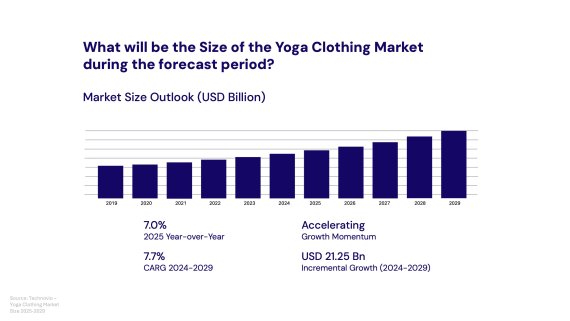
Sportswear has had a significant impact on fashion in recent years and has achieved extraordinary growth year after year. However, according to the report "Sporting Goods 2025 - The New Balancing Act" by McKinsey and WFSGI, annual growth will soon lose momentum. Instead of seven percent sales growth between 2021 and 2024, the sportswear industry will only reach six percent by 2029. This slowdown is particularly noticeable in the Asia-Pacific, Western Europe and Latin America regions. Brands therefore need to realign their strategies: Away from a pure focus on sales, towards a balance of operational efficiency and cultural relevance.
At the same time, the authors of the study diagnose a polarization of consumers: While inactivity is increasing worldwide (to 35% by 2030), the need for sports fashion as an expression of lifestyle is growing among younger, active target groups. This development requires products that combine performance with suitability for everyday use and tailor-made marketing strategies for customers who previously had little affinity for sports. At the same time, the study emphasizes the considerable market potential if sports brands and retailers actually succeed in motivating inactive people to be more physically active through targeted product innovations and marketing campaigns.
In an increasingly dynamic market environment, it can help to find additional factors for differentiation and customer loyalty. As sport, entertainment and retail become increasingly intertwined, brands are creating new approaches to their products through events, fitness offers and digital experiences. McKinsey estimates that the global market for the sale of tickets to live events will exceed the 100 billion dollar mark in 2023 and could reach 150 billion US dollars (around 131 billion euros) by 2030. This is an opportunity for retailers to build new customer loyalty through experience formats.
More about brand development, digitalization, new distribution channels, sustainable supply chains and the implementation of regulatory requirements such as the EU Supply Chain Directive at ISPO 2025 from 30 NOV. - 02. DEC. in Munich.
And what about the outdoor market, which has experienced a number of ups and downs over the last five years? According to the latest outdoor study by Technavio, "Outdoor Apparel Market Size 2025-2029", the market for outdoor sportswear is expected to grow by 4.6 percent to 3.35 billion US dollars (2.93 billion euros) between 2024 and 2029. This growth is primarily driven by the fact that the popularity of outdoor sports continues to grow. This trend is particularly pronounced in the USA, among men and in the middle and upper classes, who have the necessary income to invest in trendy, fashionable active wear.
At the same time, the growing interest in outdoor activities is leading to increased competition, with more and more new players entering the outdoor market. First and foremost through retailers' own brands and the development of outdoor lines by fashion providers. These private labels often undercut the retail prices of established brands through strategic pricing, but now offer good product quality, making them increasingly popular in developed markets such as the USA, Germany, Japan and the UK.
This development poses a challenge for major brands as they lose market share. At the same time, affordable products make it easier for consumers to get into outdoor sports.
In addition to focusing on innovation while optimizing costs, the authors of the study therefore recommend increased cooperation between brands, retailers and sports organizations in order to increase reach and customer loyalty and raise brand awareness. The conclusion of the study:
Overall, the market offers considerable growth opportunities for companies that can effectively cater to the needs of cost-conscious consumers while offering high-quality, innovative products.
Another sport is caught between wellness, self-optimization, trend sports and the need for technical clothing: running. The global market for running apparel reached a volume of 44.2 billion US dollars (38.6 billion euros) in 2024 and will grow to 69.9 billion US dollars (61.9 billion euros) by 2033, according to the study "Running Gear Market Report 2025-2033" by market research company Research and Markets. This corresponds to a growth rate (CAGR) of 5.18 percent in the period from 2025 to 2033. IMARC Group estimates the European running market at USD 13.03 billion (EUR 11.3 billion) in 2024 in its latest study "Europe Running Gear Market Size and Share" and forecasts a growth rate of 7.05% between 2025 and 2033 to reach a value of USD 24.82 billion (EUR 21.6 billion). In the retail sector, specialty and sports stores will lead the way in Europe in 2024 with a market share of 35.4 percent.
The increasing popularity of running is not only reflected in the sales of running clothing, but also in the growing number of participants in running events, from classic marathons to charity runs and trail running events. Runners who take part in such events are aware of the importance of suitable footwear, functional clothing and accessories such as hydration packs and GPS watches. All of this drives up sales.
Growth is also driven by continuous innovations in materials and shoe technologies, as well as intelligent wearables for sports and fitness trackers that support runners in their performance. Cognitive Market Research estimates the global market for running apps at 695.2 million US dollars (605 million euros), with Europe holding a market size of 208.5 million US dollars (181 million euros) in 2024, accounting for more than 30 percent of global revenues and growing at a compound annual growth rate (CAGR) of 16.7 percent from 2024 to 2031.
According to the report, men had the largest market share, but the female segment is also experiencing significant growth as more and more women discover running as a fitness activity. In addition, the growing importance of running apparel for everyday fashion is proving to be a growing trend - especially in the European market.
Directly to the findings on sustainability:
Despite all the efforts to achieve more sustainable production and consumption in the clothing industry, there is still a wide gap between desire and reality. According to a new report by the European Environment Agency (EEA), textile consumption within the EU has continued to rise in recent years. In 2019, the average citizen consumed 17 kg of textiles per year, while this figure rose to 19 kg per person in 2022. This put the textile sector in fifth place on average out of twelve household consumption categories in 2022 in terms of consumption of raw materials, water and land as well as greenhouse gas emissions. The EU faces the challenge that consumer behavior is not changing fast enough on the way to a circular textile industry.
The EEA sees the main cause of the increase in consumption in the growing influence of fast fashion and ultra-fast fashion. The combination of increased online shopping, social media influencers and low production costs for synthetic textiles has contributed significantly to their growth. Attracted by the low prices, consumers want to buy new styles faster and faster and follow more and more short-term micro-trends that are spread on social media channels. The dynamic of in and out is therefore accelerating.
At the same time, the amount of used clothing in the EU member states is growing. The total amount of textile waste in the EU has remained relatively stable since 2016 and amounted to 6.94 million tons or 16 kg per person in the last calculated year 2022. However, this amount is expected to rise again with the EU-wide separate collection obligation for textiles from 2025. Furthermore, not all textile waste ends up in Europe. Since 2000, the export of used textiles has almost tripled, from just over 550,000 tons in 2000 to 1.4 million tons in 2019. Since then, the amount has remained relatively constant, with 1.4 million tons being exported in 2023.
In terms of the amount of CO₂ emissions associated with textile consumption, greenhouse gas emissions in the EU in 2022 totaled 159 million tons of CO₂ equivalents. This corresponds to 355 kg CO₂e per person per year. This makes textiles the sixth largest household consumption category in terms of climate impact, after housing, food and mobility, and comparable to restaurants and hotels as well as leisure and culture (see Figure 5). Around 70 % of emissions are released outside Europe, primarily in Asia, where the majority of textile production is located.
The EEA therefore emphasizes the need for "systemic change" in order to make the textile industry truly sustainable. This means that all players in the industry, from politicians to consumers, must contribute to the transition to a more sustainable textile industry.
Zalando also describes in its new study that 46 percent of consumers say they have bought more clothes than they need in the last twelve months. In collaboration with GlobeScan, Zalando has investigated the causes of the attitude-behavior gap to find out how to promote more sustainable clothing and close the gap between consumers' attitudes and actual behavior.
Overcoming this trend requires more than just changing the narrative or influencing consumer behavior - it requires a fundamental shift in the way fashion is planned, marketed and sold.
This is according to the authors of the study "It takes many - Mobilizing collective action to enable more sustainable consumer choices in fashion". They note that consumers are still willing to increasingly opt for more sustainable fashion. This is because 66% of respondents state that they are already making more sustainable purchasing decisions and 71% want to buy more sustainable fashion. However, obstacles such as price (41%), lack of visibility of more sustainable options (27%), lack of guidance when shopping (24%), knowledge gaps (21%) and mistrust of sustainability claims (19%) often put the brakes on these intentions.
The study also shows that consumers cannot achieve greater sustainability simply by making better purchasing decisions. Rather, they see it as a shared responsibility and also expect brands, other consumers, governments, NGOs, influencers and social media platforms to take appropriate measures to support the transformation.
- 77 percent of respondents expect measures for more sustainable products from brands
- 72% also see themselves as having a duty
- 66% of respondents call on the EU to contribute to a more sustainable clothing industry
- 63% of respondents call on national governments to contribute to a more sustainable apparel industry
- 65% of respondents call on social media platforms to contribute to a more sustainable apparel industry
- 61 percent of respondents call on influencers to contribute to a more sustainable apparel industry
The aim is for sustainability to become the norm for brands and retailers by investing in product design, material innovation and affordability. This requires a clear regulatory framework that enables transparency and gives them the space to provide consumers with understandable and trustworthy information along the entire purchasing process. This must go beyond pure sales and also empower customers to care for, repair and recycle garments and seamlessly integrate second-hand shopping into the traditional shopping experience.
What do full closets mean for the ecological footprint? In its "Water Footprint Report", printing specialist Epson has worked out how many different items of clothing are slumbering in Europe's closets and what water consumption can be calculated from this. For example, the study found that the production, finishing and dyeing of a pair of jeans requires an average of around 18,000 liters of water, while the dyeing process for a jacket still requires an average of 3,300 liters of water. Portuguese consumers have the largest "water footprint" in Europe. On average, they own the most jeans, sweatshirts, blouses and coats. In contrast, German consumers own the most T-shirts, jackets and socks and Dutch consumers own the most underpants. Most hoodies and leggings are bought in Poland.
According to estimates by the EU Parliament, to which the study here refers, the traditional textile industry is responsible for around 20 percent of industrial wastewater worldwide.
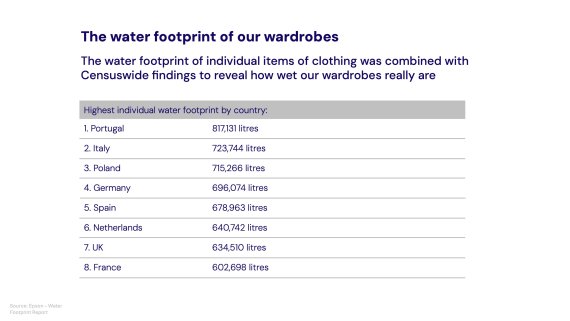
Products that are bought second-hand, on the other hand, do not produce any CO2 emissions. Second-hand fashion is therefore not only a budget-friendly alternative, but also a conscious decision with ethical and ecological aspects. The global market for second-hand clothing is on an unprecedented growth path and will reach around 367 billion US dollars (319.5 billion euros) by 2029, according to the "Resale 2025" report by US second-hand provider ThredUp. This means that this sector is growing 2.7 times faster than the entire global clothing industry and reflects a change in consumer behavior and retail strategies. According to the study, the second-hand market grew by 15 percent in 2024 alone and now accounts for nine percent of global clothing expenditure. A compound annual growth rate (CAGR) of ten percent is forecast until 2029. The US market, which is playing a key role in this transformation, is expected to reach a volume of 74 billion US dollars (64.5 billion euros) by the end of the decade, with resale growing five times faster than traditional retail at a CAGR of nine percent by 2024.
The integration of resale and other circular options into the shopping experience is also, according to the study by Zalando study, the integration of resale and other circular options into the shopping experience is crucial to drive this option forward and ensure that second-hand is not treated as a separate or inferior offering. Although retailers are competing with traditional peer-to-peer platforms, consumers:inside see the retailers' inspection procedures as a sign of quality assurance and trust.
At the same time, the struggle for more knowledge on the effects of clothing production and consumption continues.
The (TMC), one of the leading textile institutes researching the causes of fiber fragment release, has published initial research findings in a recent TMC report. Using data from the Microfibre Data Portal, which includes over 1,000 different tested fabrics, the scientists have identified important fabric properties that contribute to fiber fragmentation. For example, staple fibers tend to form fiber fragments more than filament yarns, as do knitted fabrics compared to tightly woven fabrics. Water-repellent fabrics also lose fewer fiber fragments than fabrics that soak up water, and the same applies to dyed fabrics as opposed to undyed fabrics. In general, shorn surfaces also perform better than brushed or roughened fabric surfaces.
Other important findings include the fact that the finishing phase has been neglected in previous research. The results of the TMC show that this area has a potentially strong influence on fiber fragmentation and can be more easily modified by textile manufacturers. It therefore makes sense to prioritize research in this area in the future. In order to incorporate the findings into textile production, the TMC is developing predictive models for fabric design: the machine learning model developed in this study has the potential to predict fiber fragmentation on the basis of known fabric specifications.
Sustainability is changing the future of sport and thus the demands placed on companies in the industry. This is associated with rising costs, complex supply chains and increasing regulatory pressure. At ISPO 2025, there are offers that provide orientation and help to successfully implement sustainable strategies.
The sports market is evolving from a pure performance market into a health market - with great potential for innovation, new target groups and business models. Overall, the sports market is a mirror of social developments: characterized by the joy of innovation, health awareness and lifestyle trends, but also by consumer contradictions and growing inactivity. The future of the market lies in the ability to address these areas of tension and create offers that are both ecologically and socially sustainable.
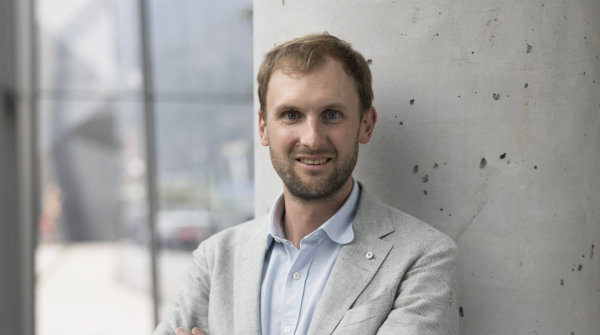
 Sports BusinessSki Mountaineering Goes Olympic: What Milano-Cortina 2026 Means
Sports BusinessSki Mountaineering Goes Olympic: What Milano-Cortina 2026 Means
- ISPO awards
- Mountain sports
- Bike
- Design
- Retail
- Fitness
- Health
- ISPO Job Market
- ISPO Munich
- ISPO Shanghai
- Running
- Brands
- Sustainability
- Olympia
- OutDoor
- Promotion
- Sports Business
- ISPO Textrends
- Triathlon
- Water sports
- Winter sports
- eSports
- SportsTech
- OutDoor by ISPO
- Heroes
- Transformation
- Sport Fashion
- Urban Culture
- Challenges of a CEO
- Trade fairs
- Sports
- Find the Balance
- Product reviews
- Newsletter Exclusive Area
- Magazine
